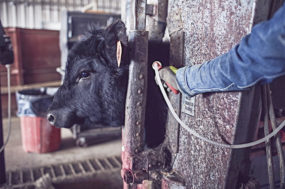The ability of the animal to develop immunity is a key component to minimizing illness in a herd. Less sickness means better performance that results in higher profitability.
Cattle develop immunity to disease from vaccinations or from a natural response after exposure by the animal.
A natural response occurs when the animal is exposed to a pathogen (disease-causing agent) and that animal’s immune system responds and creates immunity to that specific pathogen.
When this response occurs, there are memory cells developed in that animal that are able to recognize that pathogen in the future and attack it before that organism has a chance to cause illness in the animal.
The memory cells are able to do this because they have the ability to recognize not only the pathogen, but also specific parts of the pathogen called antigens.
Antigens are components of a pathogen and are unique to specific pathogens. Antigens are what the memory cells recognize on the pathogen if they occur in the animal again.
This is what happens when an animal develops a natural immunity, and this immunity may last for a long time.
Much like when people get chicken pox, they rarely get it again in their lifetime, because their body has generated memory cells for a specific antigen for the pathogen chicken pox.
Vaccines use this natural system in the animal to create these memory cells for pathogens before the animal encounters them.
People today are being vaccinated for chicken pox, with the hope that the body will create the memory cells needed to prevent the disease if they are exposed.
Our desire is to use vaccines in the same way with animals to prevent them from getting sick.
Vaccines may be modified live vaccines or killed vaccines. The modified live vaccines contain live microbes that have been modified to have the antigen components but not the ability to cause the disease in the animal.
Killed vaccines contain antigen components or pieces of the disease-causing agent and allow the immune system to create a response for immunity.
A vaccine given to pregnant animals does not mean the memory cells are transferred through the placenta to the fetus.
Vaccines are given to pregnant animals to create the immune response in the dam, which is then transferred through the milk after birth.
This provides short-term protection for the offspring until they can create an immune response themselves.
Vaccines have been used widely for some time and many producers have found varied results. The thing to remember is the condition of the animal prior to the vaccination.
If the immune system is already compromised at the time of vaccination, the likelihood of an effective response is much lower than if the animal was not in a compromised state.
This is the reasoning why feedlot cattle are often not processed upon arrival. They are likely stressed from the trip, a sale barn and multiple handing that result in their immune system not being in adequate condition to respond to the vaccination.
These animals need time to clear the stress-related hormones from their system prior to vaccination.
Vaccinations must be administered according to manufacturers’ guidelines. A vaccination labeled for an IM (intramuscular) injection will not be as effective if given subcutaneously (just under the skin).
If a producer has a question as to the route of administration, a veterinarian should be consulted.
Secondary exposure to a pathogen or a vaccine will make the immune system stronger for the specific pathogen, which increases the effectiveness of the immunity toward that pathogen.
This secondary exposure will lengthen the amount of time an animal will have immunity for a specific pathogen.
Some memory cells have a longer life span. This knowledge is utilized for the timing of administration of the secondary vaccination.
This second vaccination is commonly called a booster and creates a stronger immune response because the concentration of memory cells and their effectiveness increase with repeated exposure to an antigen.
One vaccination usually does not provide sufficient protection. Therefore, most vaccination protocols recommend a booster after a given amount of time.
Most boosters are given two to four weeks after the initial vaccination and then annually for the life of the animal.
The primary objective with the sequence of vaccination is to maintain a strong enough concentration of memory cells for a specific pathogen so the animal is highly protected if exposed to that pathogen.
It is still possible (but less likely) for the animal to still get sick if the level of exposure is greater than the animal’s level of protection.
Nutrition can also play a role in the immune response. There are some trace minerals that have been shown to enhance the immune response in cattle.
Results have varied between studies, but zinc, copper, selenium and vitamin E have been shown to enhance the immune response to vaccinations as well as natural exposure.
Vaccinations are not perfect in creating immunity, but they will at least lessen the severity of the symptoms for a specific pathogen.
A sound vaccination program should be developed with advice from a local veterinarian. All vaccinations should be administered using proper timing and technique to maintain the health and profitability of the herd. ![]()
PHOTO
If an animal’s condition is compromised at the time of vaccination, chances for an effective response may be lowered. Photo by Ryan Curtis.







